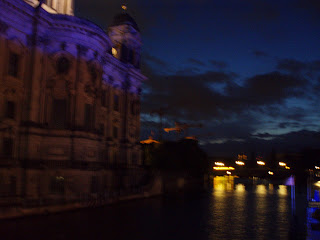Nürnberg is called the "Germanist of German cities," which is also why the Nazis loved it so much (this was the location of the big party rallies). It still has its historical old city wall and the old part of the city (Altstadt) within the wall is full of winding litle streets and medieval-style old buildlings. They are mostly reconstructions, as 90% of the city was destroyed during the war. Only Dresden suffered worse damage.
 Inside what would have been the moat of the old city wall:
Inside what would have been the moat of the old city wall:

 Below: the Burg, the fortress up on top of the hill overlooking the city.
Below: the Burg, the fortress up on top of the hill overlooking the city.
 Below: Hauptmarkt, with its shiny fountain
Below: Hauptmarkt, with its shiny fountain
 --Food in Nürnberg--
--Food in Nürnberg--Nürnberg is famous for its little sausages, they say in der Kürze liegt die Würze (the taste is in the small size), which are served three in a bun. Also famous for its gingerbread. Below is a bakery which also specializes in gingerbread: Bäckerei & Lebküchnerei (Bakery and Gingerbreadery).
 Pfifferlinge (chantarelle mushrooms) are in season right now and on every restaurant's menu. Here are some mushrooms in a cream sauce served over Semmelklöße, a Bavarian kind of dumpling.
Pfifferlinge (chantarelle mushrooms) are in season right now and on every restaurant's menu. Here are some mushrooms in a cream sauce served over Semmelklöße, a Bavarian kind of dumpling. Picnic along the river running through the city:
Picnic along the river running through the city: Nürnberg sausages: Nürnberger
Nürnberg sausages: Nürnberger Audrey enjoying a local beer in a Biergarten
Audrey enjoying a local beer in a Biergarten
--Museums--
Nürnberg also has some great museums...Below is the German National Museum lit up at night. HUGE collection, really cool.
 Sue and Audrey and I also visited the site of the former Nazi Party Grounds. They started having big rallies here in 1934, and Hitler had his favorite architect, Albert Speer, design more buildings, some which were never completed. Today they have a Documentation Center about the Nazi Party and Nürnberg (not a Holocaust or even a World War II museum, but an exhibit dedicated to how the party gained power).
Sue and Audrey and I also visited the site of the former Nazi Party Grounds. They started having big rallies here in 1934, and Hitler had his favorite architect, Albert Speer, design more buildings, some which were never completed. Today they have a Documentation Center about the Nazi Party and Nürnberg (not a Holocaust or even a World War II museum, but an exhibit dedicated to how the party gained power).







































